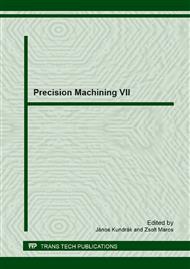[1]
A. J. de Oliveira, A. E. Diniz, Tool life and tool wear in the semi-finish milling of inclined surface, J. Materials Processing Technology 209 (2009) 5448-5455.
DOI: 10.1016/j.jmatprotec.2009.04.022
Google Scholar
[2]
O.E.E.K. Omar, T. El-Wardany, E. Ng, M.A. Elbestawi, An improved cutting force and surface topography prediction model in end milling, Int. J. Machine & Manufacture 47 (2007) 1263-1275.
DOI: 10.1016/j.ijmachtools.2006.08.021
Google Scholar
[3]
Collective work, Manufacture Engineering, in: Springer Handbook of Mechanical Engineering, Springer, New York, 2009, pp.600-620.
Google Scholar
[4]
W. Grzesik, Mechanics of Cutting and Chip Formation, in: Machining of Hard Materials, Springer, London, 2011, pp.87-144.
DOI: 10.1007/978-1-84996-450-0_3
Google Scholar
[5]
W. Grzesik, Machining of Hard Materials, in: Machining Fundamentals and Recent Advances, Springer, New York, 2008, pp.97-126.
Google Scholar
[6]
V.P. Astakhov, Machining of Hard Materials – Definitions and Industrial Applications, in: Machining of Hard Materials, Springer, New York, 2011, pp.1-18.
DOI: 10.1007/978-1-84996-450-0_1
Google Scholar
[7]
Q.Y. Cao, J. Zhao, Y.E. Li, X.X. Chen, Tool deflection modeling in Ball-end Milling of Sculptured Surface, Key Engineering Materials 516 (2012) 7-12.
DOI: 10.4028/www.scientific.net/kem.516.7
Google Scholar
[8]
L.N. Lopez de Lacalle, A. Lamikiz, J. Fernandez de Larrinoa, I. Azkona, Advanced Cutting Tools, in: Machining of Hard Materials, Springer, London, 2011, pp.65-84.
DOI: 10.1007/978-1-84996-450-0_2
Google Scholar
[9]
S. Tsurimoto, T. Moriwaki, M. Nagata, Machinability of CBN Tool in Turning of Tungsten Carbide, Key Engineering Materials 523-524 (2012) 70-75.
DOI: 10.4028/www.scientific.net/kem.523-524.70
Google Scholar
[10]
M. Arif, R. Mustafizur, Y.S. Wong, K. Liu, Micro-Ball End-milling of Tungsten Carbide for Micro-Molding and Prototyping Applications, Key Engineering Materials 516 (2012) 591-594.
DOI: 10.4028/www.scientific.net/kem.516.591
Google Scholar
[11]
M. Jin, I. Goto, T. Watanabe, J. Kurosawa, M. Murakawa, Development of cBN ball-nosed end mill with newly designed cutting edge, J. Materials Processing Technology 192-193 (2007) 48-54.
DOI: 10.1016/j.jmatprotec.2007.04.054
Google Scholar
[12]
D.K. Aspinwall, R.C. Dewes, E. -G. Ng, C. Sage, S.L. Soo, The influence of cutter orientation and workpiece angle on machinability when high-speed milling Inconel 718 under finishing conditions, Int. J. Machine & Manufacture 47 (2007) 1839-1846.
DOI: 10.1016/j.ijmachtools.2007.04.007
Google Scholar
[13]
C.E. Becze, P. Clayton, L. Chen, T.I. El-Waradany, M.A. Elbestawi, High-speed five-axis milling of hardened tool steel, Int. J. Machine Tools & Manufacture 40 (2000) 869-885.
DOI: 10.1016/s0890-6955(99)00092-9
Google Scholar
[14]
X. Cui, J. Zhao, Y. Dong, The effects of cutting parameters on tool life and wear mechanisms of CBN tool in high-speed face milling of hardened steel, Int. J. Advanced Manufacture Technology 66 (2012) 955-964.
DOI: 10.1007/s00170-012-4380-0
Google Scholar
[15]
S. Wojciechowski, P. Twardowski, Tool life and process dynamics in high speed ball end milling of hardened steel, Procedia CIRP 1 (2012) 289-294.
DOI: 10.1016/j.procir.2012.04.052
Google Scholar


